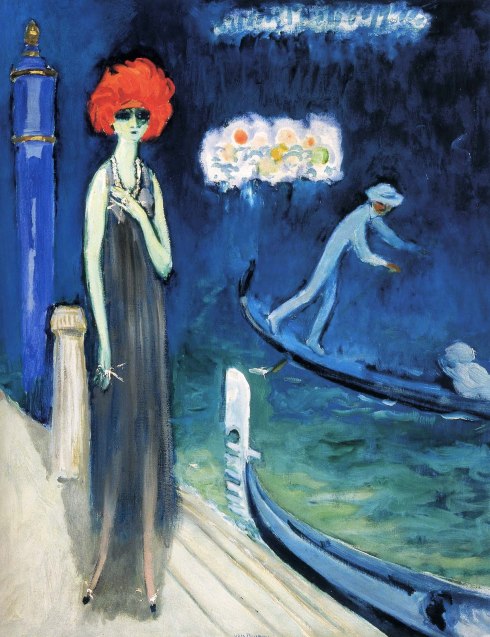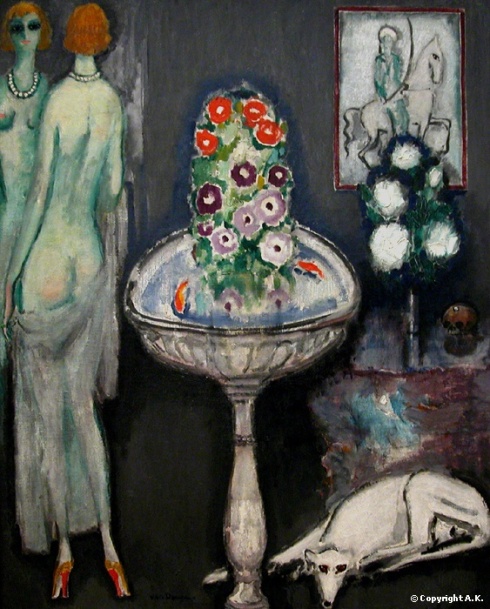‘Painting is the most beautiful of lies.’ – Kees van Dongen
 1918. La Casati by Kees Van Dongen
1918. La Casati by Kees Van Dongen
Kees van Dongen was a Dutch born French Fauvist painter famous for his sensual, somewhat gaudy female portrait, infallibly permeated with avant-garde and mystique. Out of all the Fauvists, Kees van Dongen’s work is the most appealing to me. His paintings have a great charisma for me; the decadency, the sultry face expressions of van Dongen’s ladies, palette of cold and vibrant colours, and those brilliant blue-greys, it’s all just enchanting to me. The close line between banality and glamour, clash between elegance and eroticism makes a powerful combination which draws the viewers in a world of false glamour and bleakness; a prelude to the Roaring twenties. Kees van Dongen’s female figures have often been described as ‘half drawing-room prostitute, half sidewalk princess‘.
 1920. Kees van Dongen, La violoniste
1920. Kees van Dongen, La violoniste
Kees van Dongen’s paintings have a strong erotic, modernly sensual vibe, which is not strange as he was a ‘ladies man‘. The combination of eroticism and vibrant colours made his paintings very popular in the First World World and the years immediately after the war. Still, some found his paintings too repetitive and his best work is considered to be done before 1920. Even at the age of fifteen, while he was still in the Netherlands, he used to visit the docs and sketch sailors from afar, and courtesans that gathered there too. In 1899. Kees left for Paris for good. He participated in the exhibition and Salon D’Autumne in 1905; the exhibition was controversial but it set a scene for a new art movement; the Fauvism.
Kees was one of the painters of the new generation of artists with avant-garde tendencies and an enormous elan for improvement. Main characteristics of Fauvism were vibrant colours and strong brush strokes; raw energy thrown on canvas, each brush stroke overwhelmed with emotions and passion. The combination of the two proved to be a particularly powerful one as the works of Fauvists are still valued today, and, although Kees van Dongen isn’t the most popular of them, his painting evoke the spirit of the time better than anyone elses, at least for me.
 1917. The Bowl of Flowers – Kees van Dongen
1917. The Bowl of Flowers – Kees van Dongen
This particular painting ‘The Bowl of Flowers‘, shown above, captivated me the most these past days. The painting shows a rich and eccentric heiress, Luisa Casati. She was an Italian heiress, muse, patron of arts, and in the first place an extravagant society hostess, a femme fatale who scandalised and delighted European high society for three decades. Luisa is the epitome of decadency and eccentricity and she lived her life with passion, relishing in abundance. It won’t come as a surprise that she commissioned many portraits of her to be painted from artists such as Giovanni Boldini, Romaine Brooks, and Kees van Dongen as well.
On this painting, Kees van Dongen used his tested technique of elongated figures, large eyes and strange vibrant yet mystical colours. As he was famous for portraying rich and fashionable ladies and society hostesses, he commented one time ‘The essential thing is to elongate the women and especially to make them slim. After that it just remains to enlarge their jewels. They are ravished.‘ I especially love the composition, how Luisa was placed on the far left instead of the usual central position common for portraits, and find it very interesting how she turned her back on the viewers, intriguing them even more. Her figure is elongated, her hands are thin, her waist is tiny, and that greenish skin colour, that sickly absinthe shade of green. Her pearl necklace, red high-heel shoes and thin flimsy shawl are here only to round off her mystical, sensuous and dreamy figure with all its decadency and avant-garde mood which is so appealing even today.
 1920s Luisa Casati, Kees Van Dongen
1920s Luisa Casati, Kees Van Dongen
 1913. Kees van Dongen – Tamara, The Painter’s Muse
1913. Kees van Dongen – Tamara, The Painter’s Muse
 1910. The Lace Hat, Kees van Dongen
1910. The Lace Hat, Kees van Dongen
Kees van Dongen’s ‘Femme Fatales‘ live in their own world; trapped in avant-garde, bursting with beauty and modern kind of sensuality, living at the clash of glamour and decadence. They are mythical creatures, divine and garish at the same time, living at the verge of dreams and reality; they are the fruit of Kees van Dongen’s imagination, so wonderful, so timeless, and so surreal.



Reblogged this on OKTANA by Raskolnick.
LikeLike